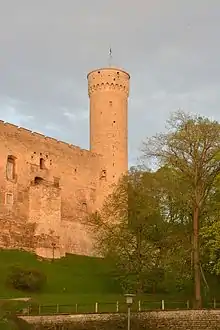Pikk Hermann
Pikk Hermann (Estonian lit. 'the Tall Hermann'; German: Langer Hermann) is a tower of the Toompea Castle, on Toompea (Domberg) hill in Tallinn (Reval), the capital of Estonia. The first part of the tower was built in 1360–1370. It was rebuilt (height brought to 45.6 metres (150 ft)) in the 16th century. A staircase with 215 steps now leads to the top of the tower. It consists of ten internal floors and a viewing platform at the top.

Pikk Hermann is situated next to the building of the Estonian parliament (Riigikogu). The flag on the top of the tower at 95 metres (312 ft)[1] above sea level is one of the main symbols of the national government in force.
.jpg.webp)
The national flag, measuring 191 centimetres (75 in) by 300 centimetres (120 in), is raised and the national anthem is played at the time of sunrise (or at 7 am, whichever is later) and lowered at the time of sunset. While it is lowered, the song "Mu isamaa on minu arm" (My Fatherland is My Love) is heard. For the first time, the national flag was raised to the top of Pikk Hermann in 1918 when Estonia became an independent country.